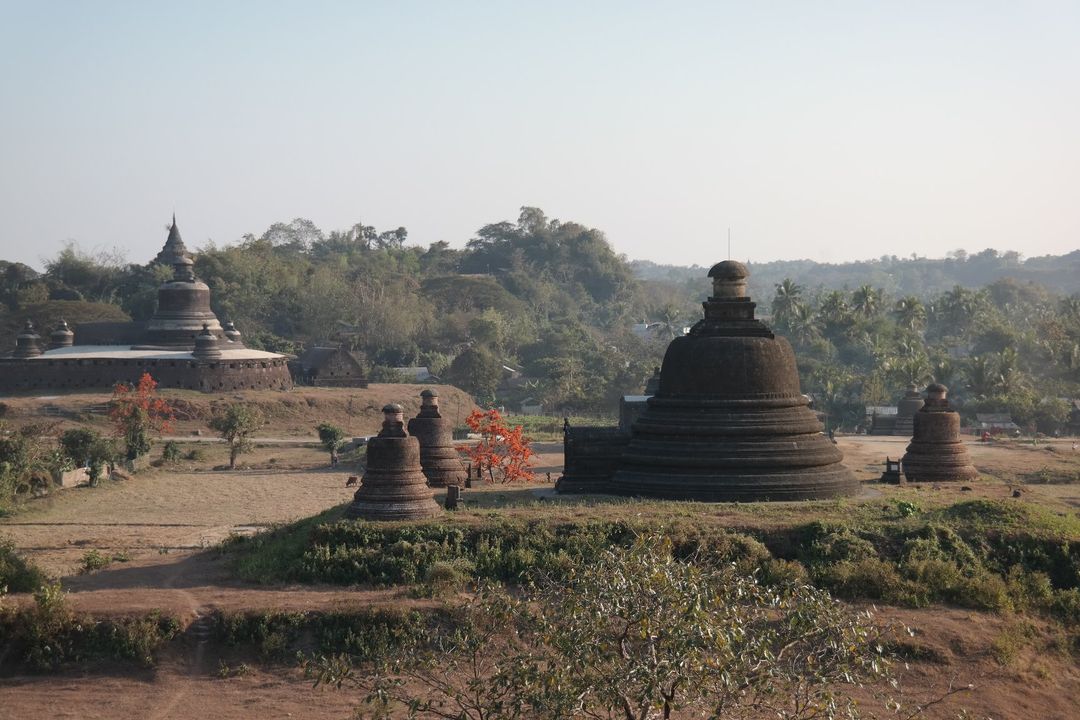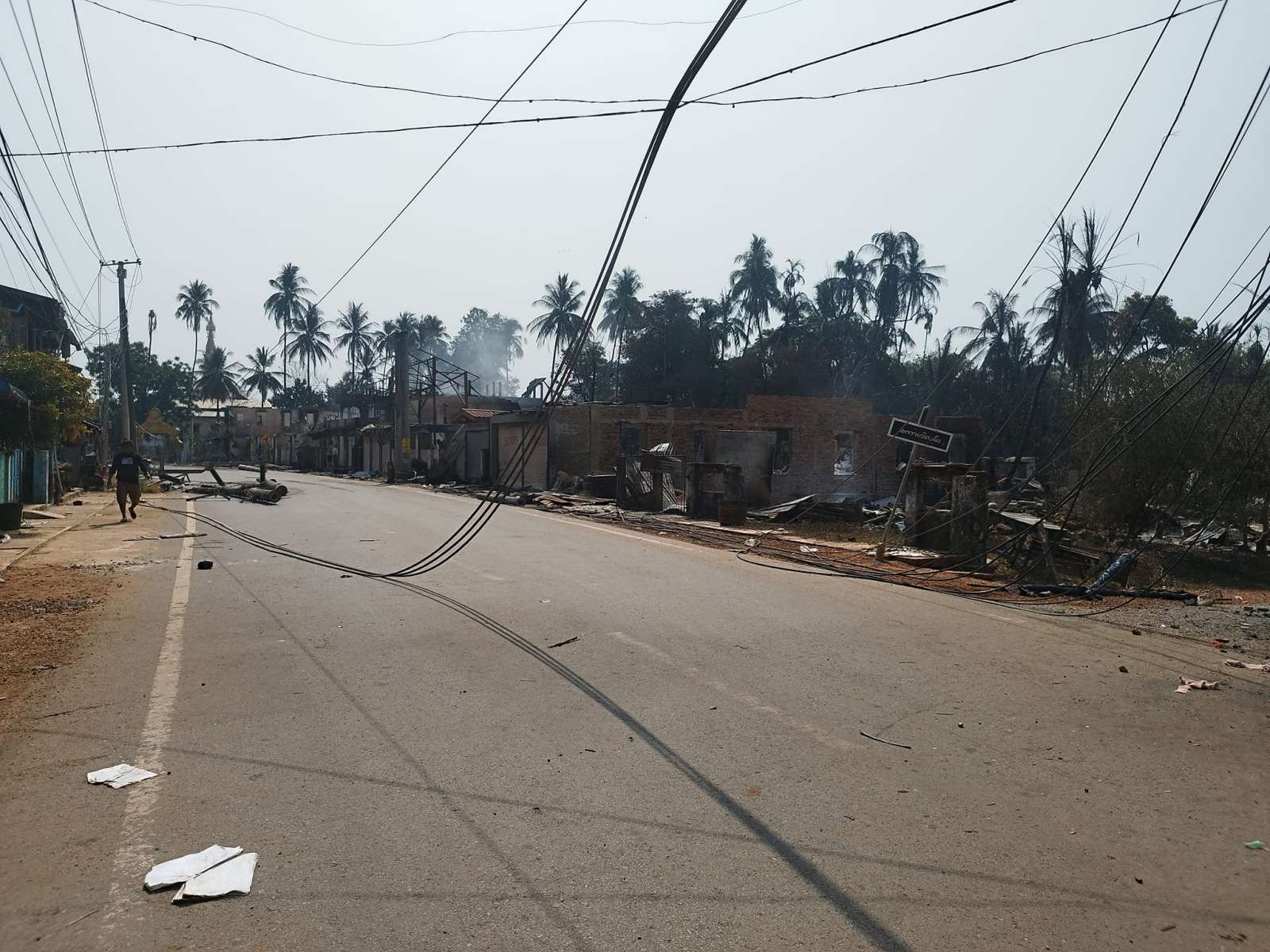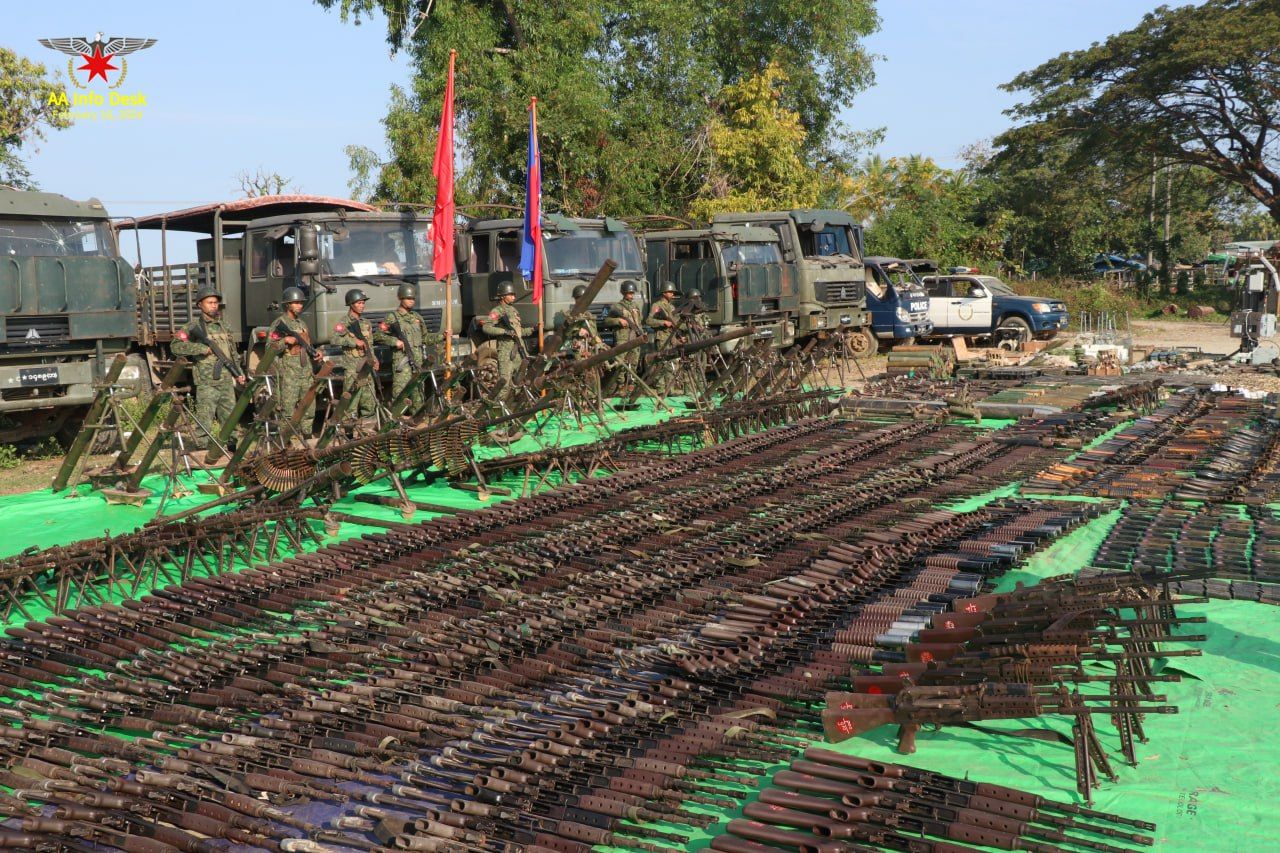Myanmar conflict update
Myanmar’s regime shrinks further towards the centre
The junta has suffered another extraordinary loss in the western state of Rakhine. Its control over the peripheries is slipping, though its grip on the centre appears firm.
By Morgan Michaels
Graphics by Brody Smith
Published March 2024
On 8 February 2024, fighters from the Arakan Army (AA) stormed the junta’s final remaining outpost in Mrauk U, the stupa-studded capital of the last Rakhine kingdom, lost to Burmese conquest in 1785. The historic moment came just five years after the AA began pursuit of its ‘Arakan Dream’, an all-out bid to conquer Rakhine State and establish a headquarters in Mrauk U Town. As their leaders posted jubilant messages on social media, Arakan fighters continued to steamroll across the state, casting regime forces into disarray. By mid-March, the AA had won primary control over nine of the 12 townships contested since fighting resumed in November last year.
With the battle still ongoing, the question has become whether the regime can retain any foothold in the north and central parts of the state. Much remains in play, including control of the Bangladesh border, the state capital at Sittwe, and the port at Kyaukphyu, where the Sino-Myanmar pipeline begins. But no matter the final outcome, the AA’s sweeping gains are already enough to enable self-rule over a large portion of the Rakhine homeland and to reshape the wider balance of power in Myanmar.

A turning point
Since seizing civil power in February 2021, Myanmar’s armed forces have been stretched along a multi-front war against opponents both old and new. In the central Dry Zone where the Bamar majority resides, the army faces hundreds of People’s Defence Forces (PDFs), localised militias that sprang up in opposition to the coup. In the borderlands, multiple ethnic armed organisations (EAOs) – well-equipped and experienced fighting forces – continue to wage war, including by assisting the newer PDFs.
Though it struggled to confront these challenges, until late 2023 several dynamics helped the regime maintain a dominant position on the battlefield. Of the approximately 20 existing EAOs, only four initially joined the post-coup armed movement while others offered statements of support or neutrality. Meanwhile, PDFs struggled to acquire arms, develop their command structures, or coordinate across theatres. These limiting factors, coupled with the regime’s overwhelming firepower and attacks on civilians, made it difficult for opposition forces to sustain large-scale offensives or seize new territories.
On 27 October 2023, the Brotherhood Alliance, a powerful bloc of ethnic armies that includes the AA, abandoned an informal ceasefire with the regime by launching Operation 1027. Within three months, the alliance won control over a large portion of northern Shan State, home to the primary trade corridor that links Myanmar with China. Witnessing the regime’s collapse there, other opposition forces stepped up attacks, presenting the junta with renewed offensives across seven different fronts.
The Brotherhood Alliance’s entry into the war represents a turning point, with the regime no longer able to hegemonise Myanmar’s battlespace or retain its foothold in all key border areas. But while it has been weakened, the army appears far from finished. In the country’s centre, the regime has managed to stabilise the situation by halting opposition offensives and, in some cases, regaining lost ground. More violence lies ahead.
Despite massive gains, end game for AA remains unclear
Though the AA has now won a dominant position over most of central and northern Rakhine, several complicating factors could shape how the battle ends. According to sources familiar with the Kunming talks, Beijing has placed considerable pressure on the AA to reach a ceasefire with the military. Given its strategic and economic interests in Kyaukphyu, China is probably reluctant to witness heavy fighting there, which could result in damage to the pipeline infrastructure. Nor is it clear that Beijing would accept the AA’s control of such assets. While the AA maintains its autonomy, its reliance on China for weapons and other support means that it cannot completely ignore Beijing’s preferences.
Another challenge for the AA is the ever-worsening impact the conflict is having on civilians. To pressure its opponent, the regime has implemented a blockade on the state, leading to severe shortages in food and medicine. Moreover, the regime controls the entire power supply to northern and central Rakhine, which flows from a small 135-megawatt plant at Kyaukphyu and two transmission lines from Bago and Magway. Should the AA move to conquer the remainder of the theatre, the regime will have little incentive to ease the blockade or allow electricity transmission from outside the state. Rakhine’s power supply would instead depend largely on the policy of Beijing, given that the Kyaukphyu plant is operated by PowerChina, a state-owned company.
In combination, these factors could potentially push the AA to consider a bargain over Kyaukphyu and Sittwe, especially if that remains Beijing’s preference. Given its past behaviours and current momentum on the battlefield, however, the possibility that the AA will try for a more total victory cannot be discounted.
Rohingya caught in the crossfire
The fighting has inflicted a heavy toll on the Rohingya population caught in the middle. In late January, regime artillery targeted AA forces entrenched at Hpon Nyo Leik village. Twelve Rohingya villagers were killed and another 32 injured in the barrage, according to Fortify Rights. On 18 February, more than 20 Rohingya villagers, including at least 10 children, were killed by what was most likely a regime air or artillery strike. Rights groups have accused the AA of operating inside Rohingya villages and say the regime has responded with disproportionate and indiscriminate artillery attacks.
In its statements, the AA continues to refer to the Rohingya as ‘Bengali’, a term which is often used to suggest that the Rohingya are not native to Rakhine State. According to one account, the AA has disappeared nine Muslim teachers since 28 January. Meanwhile, the regime has begun coercing Rohingya villagers to fight on its behalf. On 20 March, the AA released photos of what it claimed were dead Rohingya soldiers in regime uniforms. The AA also said that it clashed with Rohingya armed groups along the border, claiming that they were acting in coordination with the regime. The conflict between the AA and regime appears to be driving a deterioration in Rakhine–Rohingya communal relations.
More war ahead
Badly weakened by the Brotherhood Alliance’s offensives in northern Shan and Rakhine, the regime has lost its position as the dominant military and political actor in Myanmar. A more multipolar landscape is emerging, with implications not only for ethnic self-determination but the country’s foreign relations as well. The seizure of the borderlands by powerful opposition actors, and the establishment of new administrative mechanisms in those areas, will reshape the way international stakeholders are able to engage with the country.
While multiple opposition groups outside the Brotherhood Alliance enjoy the initiative, they face a number of enduring constraints. On the whole, no group or coalition has demonstrated the same fighting capacity, level of coordination or interoperability demonstrated by the Brotherhood Alliance. In the far north, the KIA remains burdened by a tense relationship with China and a number of fierce rivalries with both in- and out-group militias. In the southeast, different KNU brigades continue to mount operations in limited coordination with one another, reducing the overall impact on the regime.
Unless there is an external intervention or mutiny that leads to chaos within the army, the regime will probably retain its control over both the machinery of government and the centre of the country. While its losses in the peripheries will continue, they are unlikely to happen on the scale or timeline witnessed in both Rakhine and northern Shan states. Moreover, the regime will retain its ability to project force into areas it does not directly control thanks to its air, artillery and naval power.
Despite their low morale, regime soldiers have continued to fight hard. In Rakhine, reported surrenders generally appeared to occur only after a unit became surrounded, while multiple tactical commanders chose a fight to the death. Five consecutive months of punishing losses have not precipitated a breakdown in the army’s cohesion nor any meaningful increase in defections to the other side. Though widespread discontent with junta leader Min Aung Hlaing is clear, both the leadership and rank and file appear loyal to the institution and willing to fight on.

